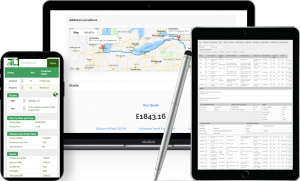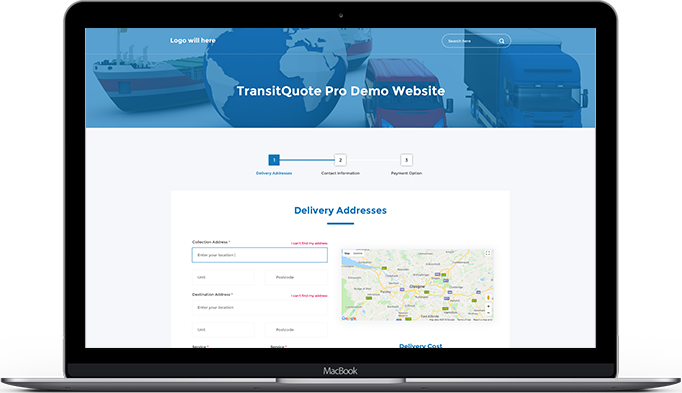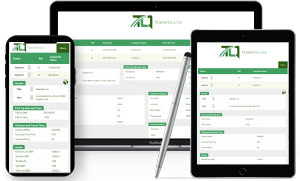
There are many different ways you can price the services that your transportation or delivery business offers.
One of our aims with the TransitQuote Pro delivery price calculator is to be as flexible as possible so that the widest possible range of pricing schemes can be automated on your business website.
With so many options for price calculation options available, we often receive questions from new customers asking the correct way to set up their rates.
In this article we will have a look at some examples of commonly used pricing schemes and how to set them up in TransitQuote Pro.
Miles or Kilometers?
The plugin uses the distance provided by Google Maps to determine which rates to use. This works with either kilometres or miles. You can choose which one to use in the Map Options of the plugin.
The Rates Tab Explained
All the rates are set up in the Rates tab of the plugin.
To understand the examples there are a few terms to be aware of:
Rates
A single pricing rate in TransitQuote consists of up to three parts – a set price, price per hour and price per mile. These are calculated and added together to give the price for a journey.
In the rates tab a single rate is shown as a single row in the table at the bottom of the Rates tab.
TranistQuote allows for multiple rates to be set up so you will see there can be multiple rows for each service and vehicle combination.
Boundary Distance
To determine which rates will be used for a given journey, TransitQuote Pro uses a boundary distance. This is the upper boundary or the maximum length of the journey for a given set of rates.
When your customer enters a journey in the booking form, the Google Maps API tells us the total distance for the journey.
The total journey distance is compared against each of the Boundary Distances in the rates table to determine which rates to use.
For example you might have 3 rows in your rates table with boundary distances 10km 40km and one row without a boundary distance.
- Journeys with a total distance of between 0 km – 10 km will use the rates in the row with the 10 km upper distance boundary.
- Journeys with a total distance between 10 km – 40 km will use the rates in the row with the 40 km upper distance boundary.
- Journeys over 40 km will use the rates in the row with no upper distance boundary (this is show as distance boundary of 0 in the rates table)
Set Price
The set price is a single amount which is added to the total price for all journeys billed at the rate in question. The amount is the same regardless of the distance.
You can use Set Price for minimum charges, for example all journeys under 10 miles could cost $15 regardless of the exact journey length.
Price Per Mile or Kilometer
This figure is multiplied by the total journey distance – the exact number of miles or kilometers in the whole journey.
Price Per Hour
This figure is multiplied by the estimated travel time for the journey. The travel time is provided by Google Maps.
The Calculation
The price calculation for a single rate is Set Price + (total distance x Price Per Mile/Km ) + (total estimated travel time in hours x Price Hour )
How To Work Out The Rates For Your Business
An easy way to work out how to enter your rates is to go through the following steps:
1) Identify the distance boundaries if you use them. If you charge the same prices regardless of distance, you only have one rate which has a distance boundary of 0.
For each distance boundary:
2) If you charge based on distance traveled, identify or choose a price per mile or km for journeys up to the distance boundary.
3) If you charge based on travel time, identify or choose a price per hour for journeys up to the distance boundary.
4) Does the business need a minimum price for journeys inside this distance boundary?
If the business is specifying a price per mile/km for the shortest journeys (less miles than the boundary) then there is no minimum price and no Set Price. The answer is no.
If the business does not specify a price per mile/km for the shortest journeys (less miles than the boundary) but instead charges a set price, then it is using a minimum price which is the Set Price for journeys below the boundary. The answer is yes.
To set a minimum price for journeys within a distance boundary, simply enter the set price in the row that contains the upper distance for the boundary for the vehicle/service combination you are working on.
Note that set price should never be used with the row that has 0 (no upper distance boundary) unless you are also charging a price per mile. This would result in the same price being charged for all journeys above your distance boundary, no matter how long they are.
5) A set price can also be used to bill for any additional costs or charges that are included for every journey within this distance boundary. Simply add the additional costs to the Set Price. For example, if the company has several extra costs which are added to every job (say, overnight stay, loading fee, unloading fee, parking fee) and the extra costs are always the same price, then they can be added together and the Total put in the “Set Price” field.
Tip: Enter The First Rate With No Upper Distance Limit
It is very important to note that there should always be a rate with 0 as the upper limit. This covers journeys longer than your highest boundary distance.
If your customer asks for a quote for a 60 mile journey and your highest boundary distance is 50 km then the 60 mile journey will be calculated as $0.
A rate with 0 upper boundary distance must be in place to cover journeys over the highest boundary distance.
Examples
Example 1
Question
How can I set up a flat rate for my parcel service? I would like to quote £150 for every 200 miles of distance covered.
Working it Out
1.Identify the distance boundaries if any.
In this example the calculation does not change depending on the length of the journey, so there is only one rate (a flat rate) which has an upper boundary distance of 0 as there is no upper limit.
2. What is the price per km?
We have been given the price per 200 miles as £150 so to work out the price per 1 mile we have to divide £150 by 200 miles giving $0.75 per mile.
3. What is the price per hour?
There is no price per hour.
4. What is the set price?
The price is calculated based on the distance only, so there is no set price.
Now enter the solution below into a single row in the rates table.
The Solution
There will be a single row in the rates table:
Boundary Distance = 0
Set Price = 0
Price Per Mile = 0.75
Price Per Hour = 0
Example 2
Question: The client has A set rate of £50 for journeys up to 30 miles.
Working it Out
1.Identify the distance boundaries if any.
There are two distance boundaries; 30 miles and after that there is no upper limit. So there is an upper boundary distance of 0.
2. What is the price per mile for each distance boundary if there is one?
There is no price per mile.
3. What is the price per hour?
There is no price per hour.
4. What is the set price?
It is £50 for up to 30 miles.
Enter the rate for this boundary into the rates table.
The Solution
There will be two rows in the rates table:
Row 1
Boundary Distance = 30
Set Price = £50
Price Per Mile = 0
Price Per Hour = 0
Row 2
Boundary Distance = 0
Set Price = 0
Price Per Mile = 1.67
Price Per Hour = 0
Example 3
Question: My customers pay £1.5 for couriers delivered up to a distance of 300 kilometres and £1.2 for couriers delivered up to 1000 kilometres.
Working it Out
1.Identify the distance boundaries if any.
In this example, we have two distance boundaries of 300 and 1000 kms. Also, for all journeys above 1000 kms, we will add 0 as the distance boundary.
2. What is the price per km?
- £1.5/km up to 300 kms
- £1.2/km up to 1000 kms
- £1.2/km over 1000 kms
3. What is the price per hour?
There is no price per hour.
4. What is the set price?
It is £1.5 for journeys up to 300 kms, and £1.2 for journeys up to 1000 kms.
It is also £1.2 for journeys above 1000 kms. So we will set the distance boundary to be 0 in the third row and the set price at £1.2.
Enter the rate for this boundary into the rates table
The Solution
You will need to create three different rows with a Set Price for each of them:
Boundary Distance = 300
- Set Price = 450
- Price Per Mile = 1.5
- Price Per Hour = 0
Boundary Distance = 1000
- Set Price = 1200
- Price Per Mile = 1.2
- Price Per Hour = 0
Boundary Distance = 0
- Set Price = 0
- Price Per Mile = 1.2
- Price Per Hour = 0
Example 4
Question: This is what I need to achieve:
Distance up to 500 miles charged at £1.30 per mile.
Distance up to 1000 miles charged at £1.30 per mile + £35.00 overnight charge.
Distance up to 1500 miles charged at £1.30 per mile + £70.00 overnight charge.
Working it Out
1.Identify the distance boundaries if any.
In this example, we have three distance boundaries of 500, 1000, and 1500 miles. Also, for all journeys above 1500 miles, we will add 0 as the distance boundary.
2. What is the price per km?
- £1.3/mile up to 500 miles
- £1.3/mile up to 1000 miles
- £1.3/mile up to 1500 miles
3. What is the price per hour?
There is no price per hour.
4. What is the set price?
The set price is £35 for up to 1000 miles
The set price is £70 for up to 1500 miles
The Solution
You will need to create 4 different rows:
Boundary Distance = 500
- Set Price = 0
- Price Per Mile = 1.3
- Price Per Hour = 0
Boundary Distance = 1000
- Set Price = 35
- Price Per Mile = 1.3
- Price Per Hour = 0
Boundary Distance = 1500
- Set Price = 70
- Price Per Mile = 1.3
- Price Per Hour = 0
Boundary Distance = 0
- Set Price = 0
- Price Per Mile = 1.3
- Price Per Hour = 0
In Conclusion
As you’ve seen, there can be a variety of scenarios of setting up rates based on your business model.
We hope this tutorial clears up any confusion over how to set up rates in TransitQuote and will help you and your business serve your customers better.



